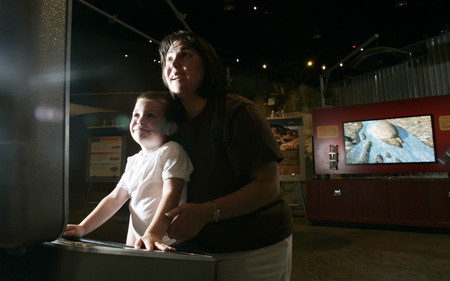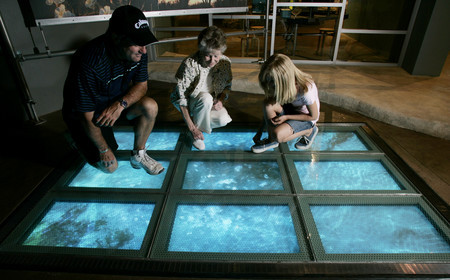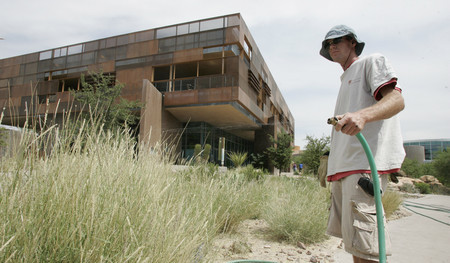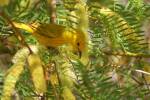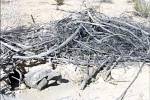Money preserves Springs
The Springs Preserve posted small gains in attendance and revenue during its second year of operation, but it still required almost $9.3 million in operational help from the Las Vegas Valley Water District.
By the time the fiscal year is closed out at month's end, more than 206,000 people will have visited the preserve and spent nearly $1.8 million there.
That's about 9,000 more visitors and $204,000 more income than the attraction saw in year one.
All told, however, the 180-acre collection of interactive exhibits, green buildings and desert plants has absorbed nearly $20 million in subsidies since the water district opened it on June 8, 2007.
And that's not counting the roughly $160 million the state's largest water utility kicked in for construction of the $235 million attraction. The district will spend the next 25 to 30 years paying that bond money back with interest.
None of that seemed to matter much to youngsters who toured the Springs Preserve with their parents and classmates on Tuesday.
One boy couldn't contain his excitement as he watched a night snake devour a dead mouse in one of the live animal exhibits.
"That is so freaking cool," the boy said.
"Hey," his father chided, "watch your mouth."
A field trip from Elizondo Elementary School just missed feeding time for the snakes, but the 54 second-graders found plenty to marvel at. So did Elizondo teacher Sima Stein.
"I learn something new every time we come," she said.
Stein paid particular attention to a display on venomous insects not found in her native New York.
"We don't have desert recluse spiders there. I want to know what to watch out for," she said. "I also listen to the kids. They know a lot."
Roughly 32,000 local school children took free field trips to the Springs Preserve during the past school year.
Water district General Manager Pat Mulroy said she doesn't measure the preserve's success or failure based on numbers alone, but that number is one she is especially proud of.
Reaching the community's young people is key, she said, since a primary purpose of the preserve is to encourage water conservation and sustainable desert living.
"The role of the water utility has changed," Mulroy said.
In the desert Southwest especially, it's not enough to merely treat and deliver water anymore; now the district must manage an increasingly scarce resource, and "the community has to be part of the solution," she said.
Of the 206,142 visitors to the preserve over the past year, about 95,000 were paying customers.
Before the preserve opened, midrange projections called for it to draw approximately 600,000 visitors in the first 12 months, most of them tourists.
With two years now in the books, the attraction is still well short of that first year figure, and tourist traffic remains almost nonexistent.
The facility attracted roughly 8,500 out-of-town visitors during its second year, a decline even from the 9,300 tourists it saw in year one.
That's a far cry from the district's stated goal of capturing about 1 percent of the local tourism market. After all, 1 percent of 37.5 million people -- the number drawn to Las Vegas in 2008 -- is 375,000.
Dick Wimmer, deputy general manager for the water district, said the preserve's marketing effort is being retooled with the help of R & R Partners, the advertising firm behind the "What Happens Here" campaign.
But Wimmer insists the district was never targeting the average Strip tourist anyway. Instead, it is after that rare visitor who comes to town more than once a year and is actively looking for things to do outside the resort corridor.
"It's roughly the same people interested in Red Rock, Hoover Dam and the Grand Canyon," Wimmer said.
And tapping even that niche market could take some time, he said. "Red Rock has had a few thousand years to establish its reputation."
Considering what the economy has done, Mulroy said she is "thrilled that the (preserve's) numbers have held or even improved in some areas."
If it takes a few more years to truly tap the tourist market, so be it, she said.
LAS VEGAS' BIRTHPLACE
The site along the east side of Valley View Boulevard between U.S. Highway 95 and Alta Drive is part historic treasure, part cautionary tale. It is considered the birthplace of Las Vegas, a desert oasis of freshwater springs that attracted the first human settlers to the area. But the springs ran dry in the early 1960s, pumped to death by the community's voracious thirst for groundwater.
Mulroy said the water district had a "stewardship responsibility" for the property, which at one time or another has been considered for residential development, a highway interchange and a golf course.
She said the preserve was never meant to be a profit center, and it has more than lived up to that.
The district subsidized the operation by $10.5 million in the first year and $9.27 million in the second. More than two thirds of that money went to cover salaries and benefits for the attraction's 74 full-time employees.
The district expects its subsidy to dip below $8.5 million next year, and continue to inch down from there until it settles at about $3 million annually.
So far, there has been little focused public criticism of the preserve or the district's decision to build it.
That could change if district officials decide to raise water rates to offset flagging revenue during the financial downturn.
No such proposal has been floated yet, but Mulroy has warned that a rate increase of some kind might prove unavoidable if the economy does not improve.
Assemblyman Joseph Hogan, D-Las Vegas, has been an outspoken critic of Mulroy and company. To him, the Springs Preserve seems like another example of their "lavish" and largely unchecked spending practices.
If the point of the preserve is to foster a conservation ethic in the community, Hogan said, the district could have saved its money and delivered that message for free by jacking up the rates of the valley's heaviest water users.
In April, the district addressed one complaint about the preserve when it slashed ticket prices for valley residents. While tourists continue to pay $18.95 for an adult admission, the local rate is now $9.95.
Wimmer said the move is expected to draw enough additional visitors to offset any loss of revenue from the price reduction.
But barring a miracle, the preserve will have to wait at least another 18 months for what figures to be its most attractive new amenity to date.
Though the 70,000 square-foot building was finished months ago, the new Nevada State Museum won't have its exhibits installed until the fall of 2010.
And even then it appears the facility will not have the staff it needs to open its doors for anything more than the occasional limited engagement, said David Millman, director of the state museum in Las Vegas.
"We couldn't have picked a worse time to do this," he said.
Lawmakers did find $5 million for exhibits this year, but the staff complement for the new museum fell victim to budget cuts.
Depending on what the economy does, Millman said it may take until the 2011 legislative session or beyond to get the needed staffing.
"When it does open, it will certainly be a real community asset," he said. "It will definitely be worth it."
As far as Hogan is concerned, Millman's predicament perfectly illustrates the contrast between "the way we force frugality on state agencies and the kind of free-spending of the water authority."
The two-term assemblyman is among those critical of Mulroy's agency for stockpiling tax proceeds and other revenue, "arguably at the expense of state agencies that are forced to cut important services."
Mulroy said she simply doesn't understand such "negativity" when it comes to the Springs Preserve, but she expects such attitudes to fade over time.
"My prediction is in five years we won't be having this conversation," she said. "People will have just accepted it. They will have come to appreciate and utilize it one way or another."
Contact reporter Henry Brean at hbrean @reviewjournal.com or 702-383-0350.



